Physical Address
304 North Cardinal St.
Dorchester Center, MA 02124
Diagnosis of skeletal anomalies is challenging and requires time and a team approach, including clinical geneticists, paediatricians and pathologists.
This chapter deals with the prenatal diagnosis of skeletal anomalies. It gives aids to diagnosis and categorises conditions by sonographic findings to help sonographers narrow the differential diagnoses.
Increasingly, with advances in genomic medicine, the definitive diagnosis can be achieved prenatally after targeted molecular genetic or metabolic investigations, sometimes by safe approaches using analysis of cell-free DNA in maternal blood.
In the absence of a definitive diagnosis prenatally, expert postmortem examination, including radiology or genome sequencing, should be offered for a diagnosis, which is essential to define recurrence risks (which can vary from 1% to 50%) and appropriate prenatal diagnosis in subsequent pregnancies.
Molecular genetic diagnosis facilitates early prenatal diagnosis in subsequent pregnancies, and storage of DNA should be encouraged, particularly in cases with an unknown diagnosis as the genetic aetiology for these conditions is increasingly being defined.
This is a rapidly moving field, and discussion with geneticists is helpful to ensure the most up-to-date information is available.
Congenital skeletal anomalies are not uncommon, occurring with an incidence of around 1 in 500. Many are amenable to prenatal detection using ultrasound. The underlying aetiology is varied and includes:
Aneuploidy
Genetic syndromes
Skeletal dysplasias
Teratogens
Isolated anomalies secondary to disruption
The sonographic detection of a fetus with a skeletal anomaly can present a challenging diagnostic dilemma. Management options can be very varied, and diagnosis may require biochemical, genetic or haematologic investigation. Increasingly more sophisticated imaging, such as magnetic resonance imaging (MRI) or computed tomography (CT), may elucidate features more easily interpreted by postnatal radiologists. Clinical genetic input is invariably useful, not only because the family history or parental examination may yield valuable clues to the diagnosis but also because this is a field that is evolving rapidly. The underlying genetic aetiology of skeletal dysplasias are increasingly known, and new, safer, approaches to prenatal diagnosis based on analysis of cell-free DNA (cfDNA) are being used.
This chapter discusses the normal embryology and sonographic appearances of fetal limb development and go on to suggest a systematic approach to the diagnosis of fetal skeletal anomalies, as well as describing some of the more common conditions in greater detail. Generalised skeletal dysplasias are discussed as well as those groups of conditions associated with more localised limb anomalies, which may or may not be part of a wider genetic syndrome. Accurate sonographic identification of skeletal abnormalities becomes increasingly important as more genes for skeletal conditions are identified, raising the potential for accurate prenatal diagnosis using molecular methods.
Fetal ultrasound diagnosis relies on the identification and accurate description of sonographic findings. Skeletal anomalies are associated with a range of genetic syndromes and dysplasias, and discussion with other specialists (in particular clinical geneticists, radiologists and orthopaedic surgeons) is necessary to try to define both the diagnosis and prognosis to inform accurate parental counselling. To be able to do this efficiently, a good understanding of terminology is required. Normal bone nomenclature is illustrated in Fig. 34.1 . The terminology used in describing abnormalities of the limbs is given in Table 34.1 .
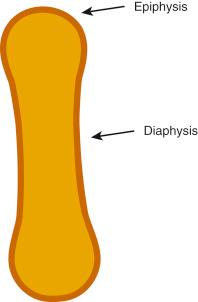
| Acheiria | Absent hand(s) | ||
| Acheiropodia | Absent hand(s) and feet | ||
| Acromelia | Shortening of the distal segments of limbs (i.e., hands and feet) | ||
| Adactyly | Complete absence of fingers, toes or both | ||
| Amelia | Complete absence of one or more limbs from the shoulder or pelvic girdle | ||
| Apodia | Absent foot (feet) | ||
| Arthrogryposis | Congenital joint contractures | ||
| Brachydactyly | Short digits | ||
| Camptomelia | Bent limb | ||
| Camptodactyly | Bent digit(s) | ||
| Clinodactyly | Incurved fifth finger | ||
| Ectrodactyly | Split (cleft) hand(s) or feet, missing central ray(s), lobster claw deformity | ||
| Hemimelia | Congenital longitudinal absence or deficiency of a forearm or lower leg bone | ||
| Kyphosis | Dorsal convex curvature of the spine | ||
| Kyphoscoliosis | Combination of lateral and anteroposterior curvature of the spine | ||
| Meromelia | Partial absence of a limb | Transverse | Defect extending across the whole width of the limb |
| Longitudinal | Defects affecting one bone along an axis | ||
| Terminal | No bony part distal to the defect | ||
| Intercalary | With recognisable parts distal to the defect | ||
| Mesomelia | Shortening of the middle segment of a limb (i.e., radius/ulna and tibia/fibula) | ||
| Micromelia | Shortening of all long bones | ||
| Oligodactyly | Absent or partially absent digit(s) | ||
| Phocomelia | Relatively normal hands or feet are attached to the trunk either directly or by extremely shortened long bones | ||
| Platyspondyly | Flattening of the vertebral bodies | ||
| Polydactyly | Extra fingers or toes | Preaxial | Extra digit on the radial or tibial side |
| Postaxial | Extra digit on the ulna of fibular side | ||
| Rhizomelia | Shortening of the proximal long bones (i.e., femur and humerus) | ||
| Syndactyly | Fused digital rays | Skin | Fused skin only |
| Osseous | Bony fusion | ||
| Scoliosis | Lateral curvature of the spine | ||
| Talipes | Club-foot | Equinovalgus | Foot twisted outwards |
| Equinovarus | Foot twisted inwards | ||
| Equinus | Extended foot |
In humans, the upper limbs develop a few days in advance of the lower limbs, with the arm buds appearing at about 5.5 postmenstrual weeks. The fetal skeleton then forms in two ways, membranous ossification (clavicle and mandible) and intracartilaginous (endochondral) when ossification occurs by calcium deposition in preexisting cartilage matrix. Fetal ossification begins in the clavicle at around 8 weeks’ gestation followed by the mandible, vertebral bodies and neural arches at around 9 weeks; the frontal bones at 10 to 11 weeks; and the long bones at around 11 weeks. Most skeletal structures can be identified sonographically by 14 to 15 weeks. The appearance of the ossification in the fetal skeleton has been studied both radiographically and sonographically using transabdominal ultrasound. However, probably the most useful indication of which structures should be identified when scanning in early pregnancy comes from a recent radiologic study of human fetuses ( Fig. 34.2 ). Identification of anomalies of skeletal development requires detailed scanning and aids such as charts of normal skeletal size, including length of long bones, clavicles, mandible, scapulae, chest size, orbital diameters, renal size and so on.

The genetic and pathological aetiology of skeletal anomalies is wide, and there have been several classifications used. These have evolved as understanding of the genetics and pathophysiology of these rare but complex disorders becomes clearer. Classifications can be based on clinical or radiological features (or both), molecular genetic aetiology or the biological structure and function of genes and proteins involved (e.g., defects in structural proteins, metabolic pathways, transcription factors etc.) or a hybrid of both. A classification based on sonographic findings is the most useful classification for the prenatal diagnostician ( Table 34.2 ), but there can be considerable overlap in conditions, so a table listing the common diagnoses with gene location, when known; inheritance; and main sonographic findings is also given ( Table 34.3 ).
| Sonographic finding | Condition | Other investigations to be considered |
|---|---|---|
| Skull | ||
| Hypomineralised | Osteogenesis imperfecta types IIA and IIC Achondrogenesis type I Hypophosphatasia (severe neonatal form) |
Parental fracture history for possible somatic mosaicism a a Parental ALP and urinary phosphoethanolamine a |
| Mild hypomineralisation | Achondrogenesis type 2 Cleidocranial dysostosis Osteogenesis imperfecta IIB |
a Parental history a Parental history as above |
| Cloverleaf | Thanatophoric dysplasia type II Occasionally in SRPSs Antley-Bixler syndrome Craniosynostosis syndromes (Pfeiffer, Crouzon, Saethre-Chotzen syndromes) |
NIPD a a a a |
| Spine | ||
|---|---|---|
| Hypomineralised | Achondrogenesis type I | ∗ |
| Disorganised | Jarcho-Levin syndrome Spondylocostal dysplasia Dyssegmental dysplasia Some chondrodysplasia punctatas VATER/VACTERL |
Consider metabolic screening a |
| Face | ||
| Frontal bossing | Thanatophoric dysplasia Achondroplasia Acromesomelic dysplasia |
NIPD |
| Depressed nasal bridge | Chondrodysplasia punctatas Warfarin embryopathy |
Drug history, karyotype, ARSE deletion screen (CDPX1) a Metabolic investigations: very-long-chain fatty acids and sterol profile, CVS for peroxisomal enzyme studies, maternal history of autoimmune disease |
| Micrognathia | SEDC Stickler syndrome Campomelic dysplasia |
Karyotype a a a |
| Cleft lip | Majewski syndrome Oral facial defect IV |
a a |
| Legs | ||
|---|---|---|
| Isolated straight, short long bones | IUGR Constitutional short stature |
Fetal and maternal Doppler, maternal Down syndrome screening biomarkers, obstetric history |
| Femoral bowing | Campomelic dysplasia Osteogenesis imperfecta Hypophosphatasia |
As above a a a |
| Talipes | Campomelic dysplasia Diastrophic dysplasia |
NIPD for sex determination a a |
| Stippled epiphyses | Rhizomelic chondrodysplasia punctata Conradi Hunermann syndrome X-linked recessive chondrodysplasia punctata Warfarin embryopathy Maternal SLE |
Drug history, metabolic investigations; very-long-chain fatty acids and sterol profile, CVS peroxisomal enzyme studies, a maternal history of autoimmune disease |
| Thorax | ||
|---|---|---|
| Narrow with short ribs | SRPSS Jeune asphyxiating thoracic dystrophy Thanatophoric dysplasia Osteogenesis imperfecta types IIA, C and B Campomelic dysplasia Achondrogenesis Hypochondrogenesis Paternal UPD14 |
a a NIPD a a a a a a |
| Beaded ribs | Osteogenesis imperfecta type IIA and C | a |
| Polyhydramnios | Achondroplasia Thanatophoric dysplasia Paternal UPD14 |
NIPD a NIPD a a |
| Diagnosis | Gene or location | Genetics | Gestational age at presentation (wk) | Limbs | Thorax | Spine | Skull | Other Features | ||||
|---|---|---|---|---|---|---|---|---|---|---|---|---|
| Short | Bowed | Fingers | Joints | Ribs | ||||||||
| Achondrogenesis IA/IB | TRIP11 (1A); SLC26A2 (DTDST) (1B) |
AR | 12 | +++ | Narrow | Short, +/- beaded | Hypo | Hypo | Oedema | |||
| Achondrogenesis II | COL2A1 | AD | 12 | ++ | Narrow | Short | ||||||
| Achondroplasia | FGFR3 | AD | >24 | + | +/- mild | Short | +/- small | Frontal bossing | ||||
| Acromesomelic dysplasia | NPR2, GDF5, BMPR1B | AR | Around 22 | + | Short | +/- small | Frontal bossing | |||||
| Beemer-Langer | Unknown | AR | Around 20 | + | Poly | Small | Short | Cloverleaf | ||||
| Campomelic dysplasia | SOX9 | AD | 16–20, var | Legs | Legs | Talipes | +/- small | Micrognathia, cardiac defects, sex reversal in males | ||||
| Conradi Hunermann CDP (CDPX2) | EBP | XLD | Var | + Stippled | Stippled | |||||||
| Diastrophic dysplasia | SLC26A2 (DTDST) | AR | >16 | + | Hitchhiker thumbs | Talipes | Micrognathia | |||||
| Ellis-van Creveld syndrome | EVC, LBN (EVC2 | AR | From 16 | + | Poly | Narrow | Short | Cardiac anomaly | ||||
| Hypophosphatasia (severe neonatal form) | TNSALP | AR | >12 | ++ | ++ | Hypo | ||||||
| Jeune asphyxiating thoracic dystrophy | IFT80, DYNCH2H1, TTC21B, WDR19 and > 6 others | AR | From 16, variable | + | +/- poly | Narrow | Short | CNS anomaly | ||||
| Kniest syndrome | COL2A1 | AD | Variable | + | Mild | Short | Micrognathia, depressed nasal bridge | |||||
| Majewski syndrome (SRPS2A; SRTD6) | NEK1 | AR | >12 | ++ | Ovoid tibia | Poly | Narrow | Short ++ | Renal, cardiac, CNS, genital | |||
| Osteogenesis imperfecta types IIA/C and IIC | COL1A1 COL1A2 | AD, gm | >12 | +++ | +++ | Narrow | Short, beaded | Hypo | ||||
| Osteogenesis imperfecta type IIB | COL1A1 COL1A2 | AD, gm | >16 | ++ | + | (Narrow) | (Beaded) | |||||
| Osteogenesis imperfecta type III | COL1A1 COL1A2 | AD, gm | 20 | + | Legs | |||||||
| Osteogenesis imperfecta type IV | COL1A1 COL1A2 | AD, gm | >20 | Mild, femora | ||||||||
| Rhizomelic CDP (RCDP1,2,3,5) NB Overlapping heterogeneous peroxisomal disorders, Zellweger syndrome |
PEX7, GNPAT, AGPS, PEX5 | AR | 20 | Rhizomelic stippled | Stippled | Nasal hypoplasia, cataracts | ||||||
| Saldino-Noonan syndrome (SRPS2B; SRTD3; ATD3) | DYNC2H1 | AR | >12 | ++ | Poly | Narrow | Short ++ | Renal, cardiac, genital | ||||
| SEDC | COL2A1 | AD | >12 | ++ | Short | Micrognathia | ||||||
| Thanatophoric dysplasia I | FGFR3 | AD | <16 | Severe micromelia | (Mild) | Short trident | Small ++ | Short ++ | Normal | Frontal bossing | ||
| Thanatophoric dysplasia II | FGFR3 | AD | <16 | Severe micromelia | (Mild) | Short, trident | Small++ | Short ++ | Cloverleaf | Frontal bossing | ||
| X-linked recessive CDP (CDPX1) |
ARSE | XLR | Variable | + stippled | Short | Stippled | Stippled larynx and trachea |
Risk factors for skeletal anomalies include:
Family history
Drugs in early pregnancy
Maternal disease
Abnormal findings on routine ultrasound
Clearly, diagnosis in families in which there has already been an affected child or when one parent is affected with a dominantly inherited condition can be more straightforward than interpretation of findings that arise de novo . For some dominantly inherited conditions, one parent may manifest mildly or subclinically because of somatic (alteration in the DNA that occurs after conception) mosaicism but be at high risk for a more severely affected offspring who has inherited the mutation constitutively (nonmosaic), examples including osteogenesis imperfecta (OI) and spondyloepiphyseal dysplasia congenita (SEDC).
Knowledge of the sonographic features and natural history of the condition can aid prenatal diagnosis, but parents do need to be aware that some conditions (e.g., achondroplasia) may present relatively late and not be amenable to sonographic diagnosis until well into the second trimester. Others are more variable (e.g., hypochondroplasia) and are not obvious until after birth or in early childhood. For these reasons, molecular diagnosis may be preferable in families in which the gene has been identified before pregnancy. In the past, this required an invasive test (chorionic villus sampling) with its small risk for iatrogenic miscarriage to obtain fetal genetic material for testing. However, technical advances have made noninvasive prenatal diagnosis (NIPD) based on analysis of cell-free fetal DNA in maternal blood possible for several skeletal dysplasias. If the precise mutation is known before pregnancy, then bespoke NIPD may be possible.
With rapid advances in molecular genetics, the underlying genetic aetiology for many of these conditions is known, and it is imperative that tissue is available from affected pregnancies if parents are subsequently to be given the opportunity of early testing. Many conditions are heterogeneous (meaning that the causative mutation(s) may reside in any one of a number of different genes) so that extensive genetic analysis before pregnancy may be required before prenatal molecular testing can be offered. Many families may wish to avoid the risks associated with invasive prenatal testing. The advent of noninvasive prenatal testing using free fetal DNA in the maternal plasma means that parents are increasingly able to get a diagnosis without risk as this technology progresses. Nonetheless, genetic workup before pregnancy will be required for this technology as well as for traditional invasive testing.
Although drugs are now extensively tested before release onto the market, there are still those used regularly that may result in skeletal malformations if taken in early pregnancy ( Table 34.4 ). Furthermore, there is good evidence that some recreational drugs, if used in early pregnancy, can cause skeletal anomalies, a postulated vascular effect being responsible for some drugs (e.g., cocaine).
| Drug or substance | Skeletal anomalies | Other sonographic findings |
|---|---|---|
| Warfarin | Rhizomelic shortening of limbs, stippled epiphyses, kyphoscoliosis | Flat face; depressed nasal bridge; renal, cardiac and CNS anomalies |
| Sodium valproate | Reduction deformity of arms, polydactyly, oligodactyly, talipes | Cardiac and CNS anomalies, spina bifida, orofacial clefting |
| Methotrexate | Mesomelic shortening of long bones, hypomineralised skull, syndactyly, oligodactyly, talipes | CNS anomalies, including neural tube defects, micrognathia |
| Vitamin A | Hypoplasia or aplasia of arm bones or digits | CNS and cardiac anomalies, spina bifida, cleft lip and palate, diaphragmatic hernia, exomphalos |
| Phenytoin | Stippled epiphyses | Micrognathia, cleft lip, cardiac anomalies |
| Alcohol | Short long bones, reduction deformity of arm bones, preaxial polydactyly of hands, oligodactyly, stippled epiphyses | IUGR, cardiac anomalies |
| Cocaine | Reduction deformities of arms +/- legs, ectrodactyly, hemivertebrae, absent ribs | CNS, cardiac, renal anomalies, anterior abdominal wall defects, bowel atresias |
The most common maternal conditions that can result in fetal musculoskeletal anomalies ( Table 34.5 ) include:
Diabetes
Myasthenia gravis
Myotonic dystrophy
| Sonographic findings | Maternal condition | Maternal diagnosis |
|---|---|---|
| Caudal regression Femoral hypoplasia |
Diabetes | Glucose tolerance test |
| Multiple joint contractures (arthrogryposis) | Myasthenia gravis | Anti–acetylcholine receptor antibodies |
| Talipes and polyhydramnios | Myotonic dystrophy | Examine for signs of myotonia, facial appearance, genetic referral |
| Short limbs, stippled epiphyses, depressed nasal bridge | Systemic lupus erythaematosus | Autoimmune screen, history |
Other conditions such as systemic lupus erythaematosus (SLE) and hypothyroidism can also cause skeletal changes but less commonly. Poorly controlled, insulin-dependent diabetes is the most common maternal condition that can result in significant skeletal anomalies in fetuses, which include developmental field defects of the spine, vertebral segmentation defects, caudal regression syndrome and deficiencies of the limbs (particularly femoral hypoplasia, tibial hemimelia, preaxial hallucal polydactyly) as well as anomalies of other viscera, in particular the heart and urogenital tract.
In maternal myasthenia gravis, transmission of acetylcholine receptor antibodies to the fetus can result in generalised arthrogryposis and neonatal or infant death. In some instances, the antibodies are specific to the fetal subunit of the acetylcholine receptor, and the mother may be asymptomatic.
Myotonic dystrophy is an autosomal dominantly inherited condition which, when transmitted maternally to the fetus, can result in congenital myotonic dystrophy (CMD). Mothers with clinically detectable neuromuscular manifestations of myotonic dystrophy have between a 10% and 50% risk for having a baby with CMD. In pregnancy, characteristic sonographic findings include talipes, decreased fetal movements or breathing and polyhydramnios. Affected neonates are very floppy and often have respiratory problems requiring ventilatory support, and the mortality rate is high (20%). Most survivors have significant developmental delay and a reduced life expectancy. The finding of talipes and polyhydramnios in a euploid fetus should prompt examination of the mother for signs of myotonic dystrophy.
Maternal SLE can cause a variety of problems in fetuses, including limb shortening with stippled epiphyses; facial anomalies, in particular a depressed nasal bridge; and an abnormal appearance of the spine secondary to extra calcification. Other findings can include bradycardias, growth retardation and hydrops.
The first clue that there may be a skeletal anomaly present is often the identification of a short femur at the time of a scan for another reason, either a routine fetal anomaly scan at around 20 weeks’ gestation or a scan later in pregnancy for other indications. Careful examination of the rest of the fetal anatomy can reveal further signs of a skeletal dysplasia ( Table 34.6 ). If limb shortening appears to be isolated, then intrauterine growth restriction (IUGR) must be considered as a possible aetiology. In these circumstances, review of maternal serum screening results for levels of pregnancy-associated plasma protein A (PAPP-A), β-human chorionic gonadotrophin (β-hCG) and maternal serum alphafetoprotein (MSAFP) and assessment of fetal and maternal Dopplers can be useful diagnostic aids. In a 4-year period at University College London Hospital of 130 fetuses referred with ‘abnormal’ femora (short, bowed, hypoplastic), 42 fetuses were thought to have short, straight femurs or limbs with no other sonographic abnormalities detected. Only 2 of these had a skeletal dysplasia. Many were normal and had either had an incorrect assignment of gestational age or familial short stature, but 31% had IUGR.
| Anatomical part | Features |
|---|---|
| Long bones | Length Pattern of shortening
Which bones |
| Spine | Length Mineralisation Alignment (hemivertebrae) Organisation (stippling) |
| Cranium | Shape Mineralisation (acoustic shadow) |
| Face | Profile: frontal bossing
Cleft lip |
| Chest | Size Ribs: length
|
| Hands | Short fingers (trident hand) Camptodactyly Ectrodactyly Polydactyly Oligodactyly |
| Feet | Size Polydactyly |
| Joints | Contractures Pterygia Talipes Radial club hand |
| Associated abnormalities | Cardiac abnormalities Renal anomalies Intracranial abnormalities Genital anomalies |
| Fetal and maternal Dopplers | Screen for IUGR |
The skull should normally be rugby ball in shape and cast a good acoustic shadow, indicating normal mineralisation. Decreased mineralisation is indicated by an anechoic skull vault, which casts little or no acoustic shadow ( Fig. 34.3 ). Furthermore, the intracranial contents will be more clearly visualised than normal, and because the cerebral hemispheres appear relatively anechoic, the appearances are not infrequently mistaken for cerebral ventriculomegaly. Careful examination will reveal the characteristic and hyperechoic, normally located, choroid plexus (see Fig. 34.3 ). In conditions associated with hypomineralisation in later pregnancy, the skull shape can readily be deformed by pressure from the transducer. Variation in skull shape can be seen rarely in some craniosynostosis syndromes, and a cloverleaf skull is also seen in thanatophoric dysplasia type II.
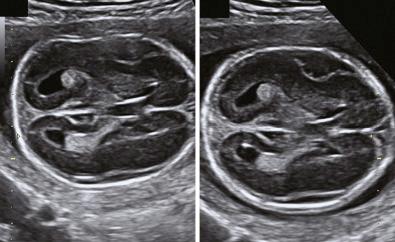
The spine should be examined carefully in all three orthogonal planes. There may be absent or decreased mineralisation, but it must be remembered that ossification of the cervical and sacral vertebral bodies is a late event; the sacral vertebral bodies are not ossified until 27 weeks’ gestation. Vertebral segmentation anomalies (hemivertebrae, butterfly vertebrae, fused vertebrae) ( Fig. 34.4A and B ) can occur with or without associated rib anomalies. The appearance of general disorganisation may indicate ectopic calcification seen in some chondrodysplasia punctates (see Fig. 34.4B and C ) or bony developmental abnormalities as in Jarcho-Levin syndrome and other spondylocostal dysplasias, VACTERL association (vertebral anomalies, anorectal malformations, cardiovascular anomalies, tracheoesophageal fistula, oesophageal atresia, renal (kidney) or radial anomalies and limb defects) and maternal diabetes (see Fig. 34.4E ).
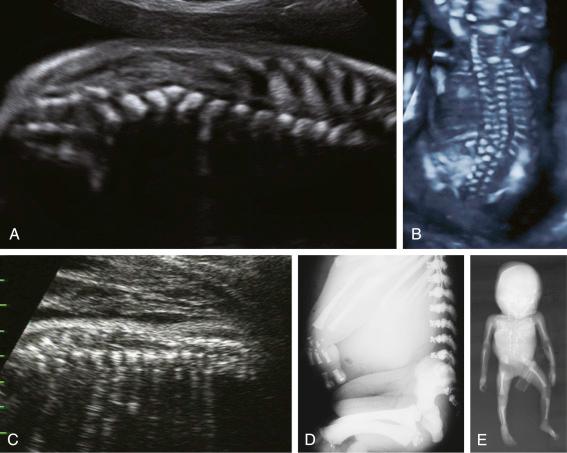
Many skeletal dysplasias have associated facial anomalies. The face should be examined in the coronal view to exclude a cleft lip, which in some conditions, such as oral facial digital syndrome type IV or Ellis-van Creveld syndrome, can be very small and difficult to detect ( Fig. 34.5 ). An axial view of the palate should be visualised in order to detect significant degrees of cleft palate, which can be associated with several dysplasias. A sagittal view will reveal micrognathia, flattening of the facial profile, frontal bossing or a depressed nasal bridge. Measurement of the mandible and orbital diameters can be useful but may be more difficult to achieve in later pregnancy with increasing acoustic shadowing from surrounding bony structures.
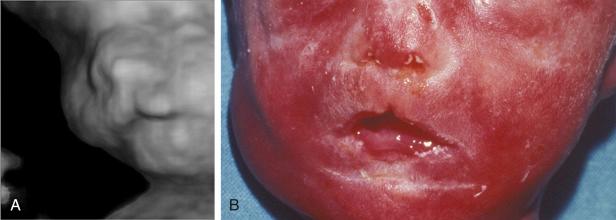
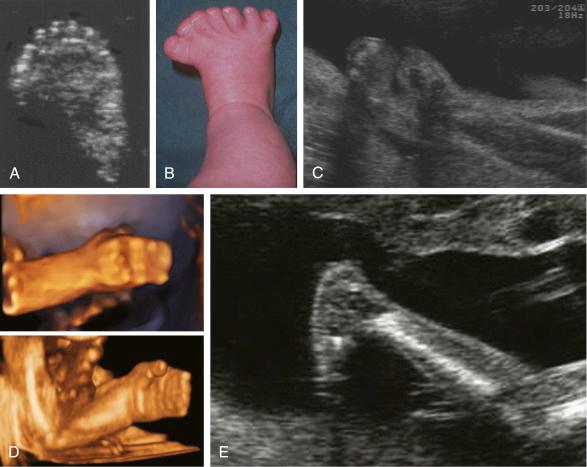
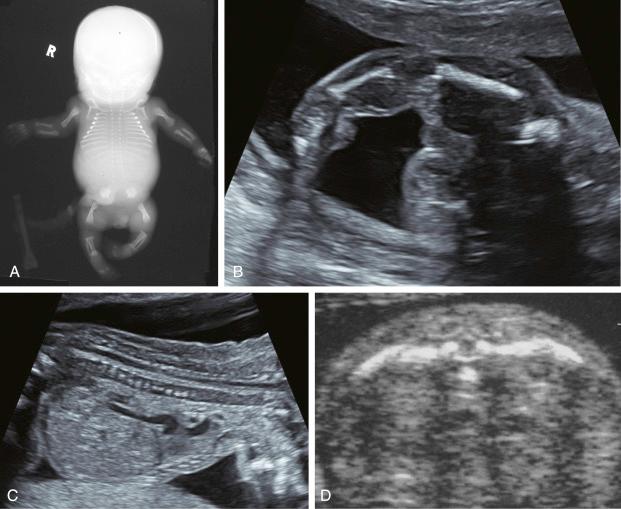
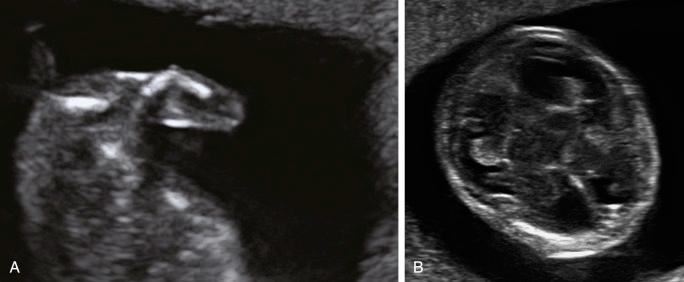
Length of long bones should be checked against appropriate charts of long bones length. The pattern of shortening is a useful diagnostic aid. There may be generalised shortening of all long bones (micromelia). It may be more marked in the proximal long bones (rhizomelia) or the forearms and lower legs (mesomelia). In some conditions, the changes may be confined to the legs (e.g., campomelic dysplasia) or arms (e.g., Holt Oram syndrome). Deformation of the bones is a very useful diagnostic feature. The position and degree of bowing or fracturing should be noted. Bones may appear short, thick and crumpled, indicating severe degrees of fracturing and undermodelling (see images of fetuses with OI in Fig. 34.9 ). Deformity; hypoplasia; or absence of tibia, fibula, radius or ulna may be present. The ends of the bones should be carefully examined to exclude epiphyseal stippling that might indicate a chondrodysplasia punctata. If stippling is identified, various metabolic and cytogenetic investigations can be done to define the underlying aetiology (see section on chondrodysplasia punctata and Fig. 34.20 for examples). Expanded metaphyses may be seen in Kniest syndrome.
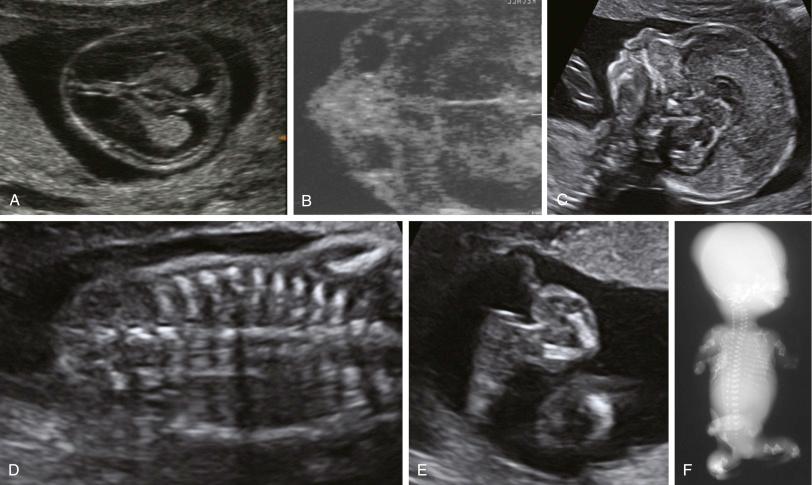
The joints may be abnormal in a wide range of skeletal, neurologic and neuromuscular conditions as well as a heterogeneous group of hereditary distal arthrogryposes. Talipes in particular can be a feature of several dysplasias. The presence of webbing or pterygia may be helpful diagnostically.
Polydactyly, either pre- or postaxial, can be a feature of a number of conditions ( Fig. 34.6A and B ). Oligodactyly, ectrodactyly and syndactyly are less common features ( Fig. 34.6C and D ) but are good clues to the diagnosis when present. Rocker bottom feet are seen in trisomy 18 and some of the contractural syndromes ( Fig. 34.6E ).
The limb girdles, shoulder and pelvis can be more difficult to examine. However, some skeletal dysplasias have hypoplastic clavicles (cleidocranial dysostosis, pycnodysostosis) or scapulae (camptomelic dysplasia).
Many lethal dysplasias are associated with thoracic abnormalities. Nomograms of thoracic circumference are available, but a small chest can often be identified by observation alone. In normal circumstances, the thorax and abdomen should be approximately the same size viewed in the axial plane, and sonographic comparison can help indicate a small chest as, for example, in OI and thanatophoric dysplasia (see Figs. 34.10 and 34.12 in these sections for examples). The heart should normally occupy one third of the chest. If the ribs are short, the heart will appear to occupy a greater proportion of the chest when viewed in the axial plane and, when there is extreme shortening of the ribs, as, for example, in thanatophoric dysplasia, the heart may appear to lie outside the thoracic cavity (see Fig. 34.12 ). In the sagittal section, the thorax will be narrow and the abdomen protuberant, a configuration that has given rise to the expression ‘champagne-cork appearance’. The chest can also be small secondary to a short spine, as in some of the spondylodysplasias. In these situations, the chest may appear small in a sagittal plane but, when viewed in the axial plane, the ribs appear of normal length and the heart occupies the appropriate proportion of the thoracic cavity (see Fig. 34.14 ). The ribs themselves should be examined carefully as they may be short, thick, thin, beaded or irregular in organisation or number. Short ribs (extending less than halfway around the chest in transverse section) can be viewed in the axial plane (see Figs. 34.7, 34.10 and 34.12 for examples), and they should be examined in a longitudinal plane to exclude beading, which is indicative of fracturing (see Figs. 34.9 and 34.10 ). Disorganisation of the ribs (and spine) may be features of conditions such as Jarcho-Levin syndrome (see Fig. 34.4E ).
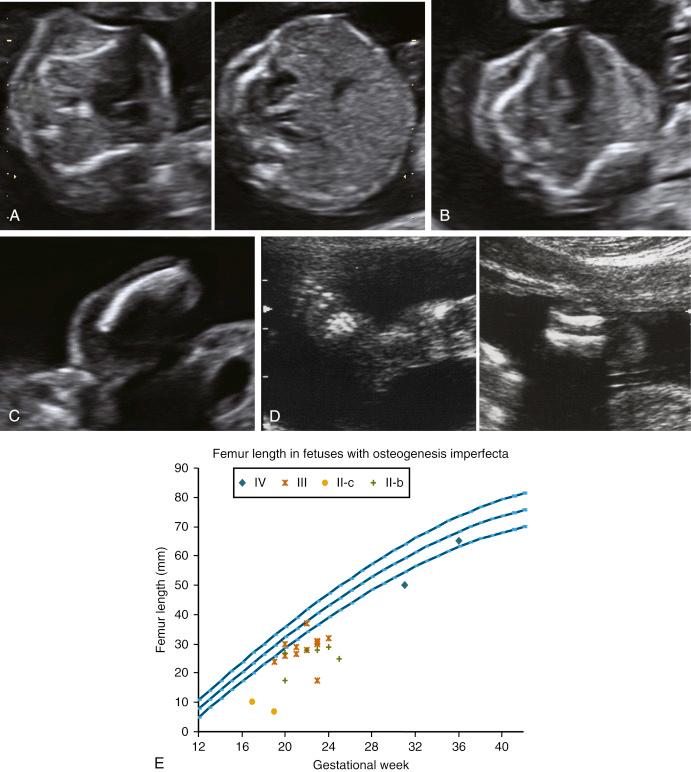
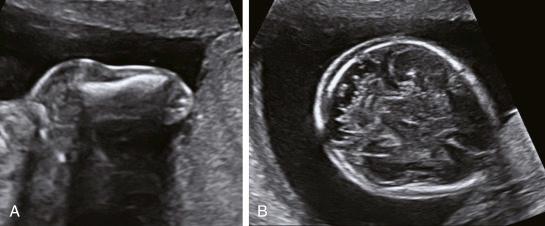
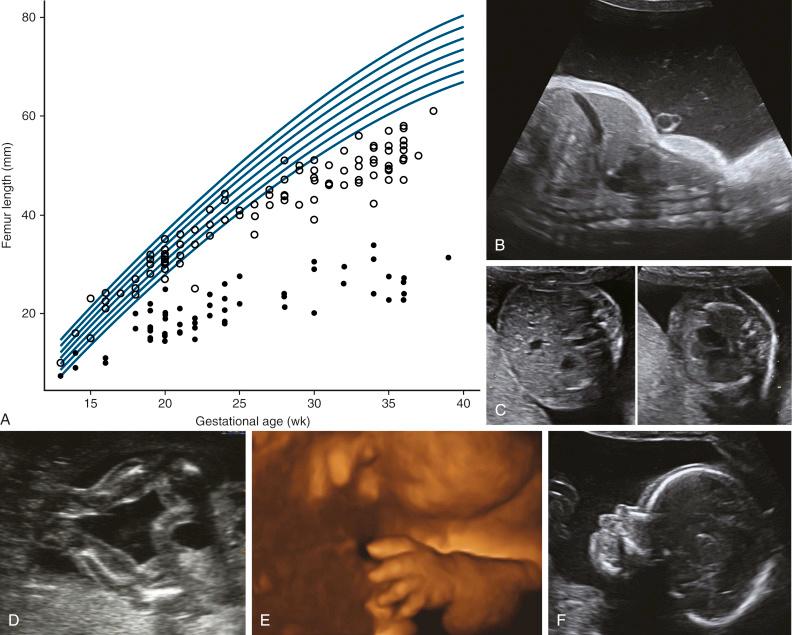
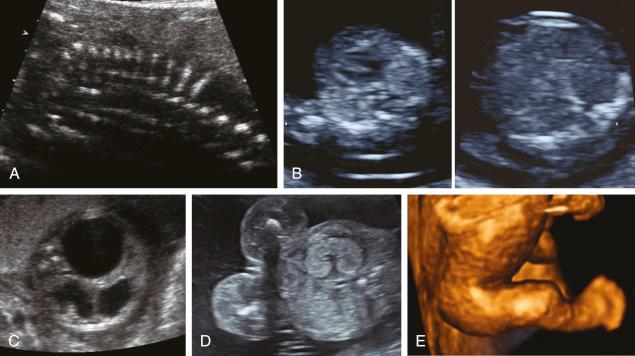
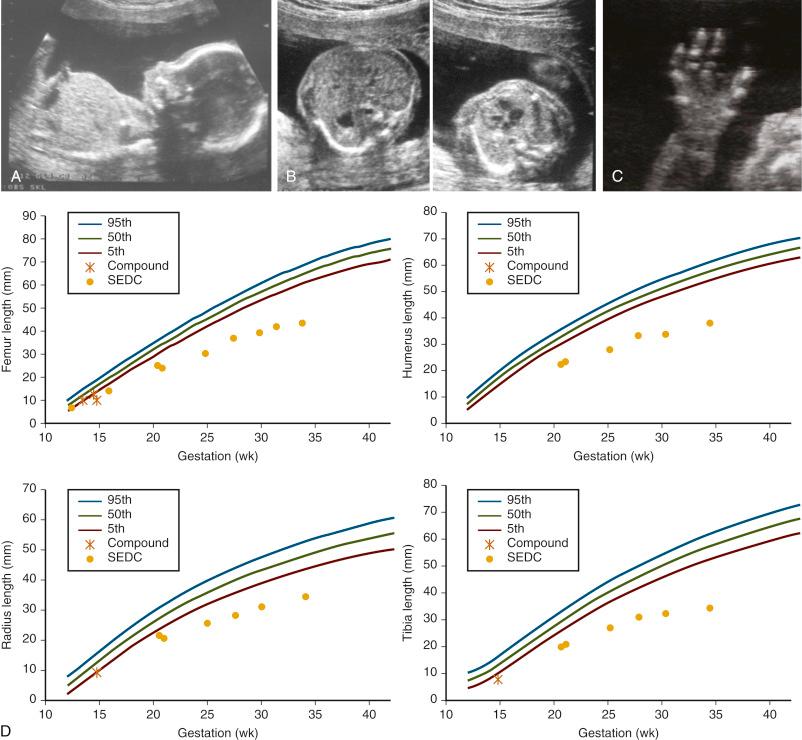
One of the earliest signs of a musculoskeletal problem is an increased nuchal translucency (NT), which has been reported in many skeletal dysplasias. Later in pregnancy, this is represented by an increased nuchal fold and generalised skin thickening, as the skin appears to outgrow the bones. In some conditions frank hydrops can also occur.
Become a Clinical Tree membership for Full access and enjoy Unlimited articles
If you are a member. Log in here